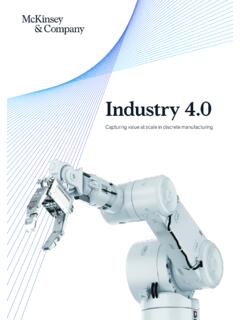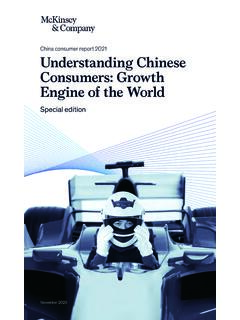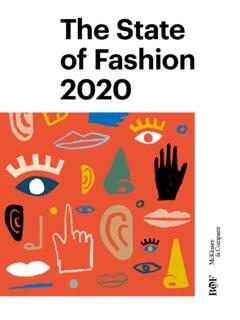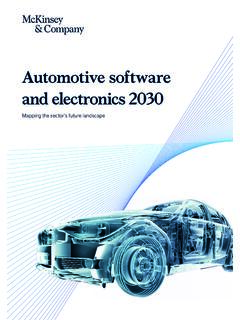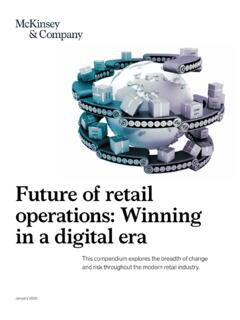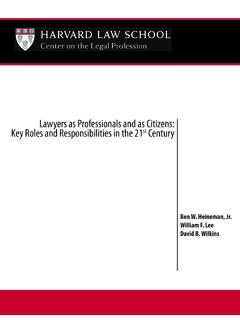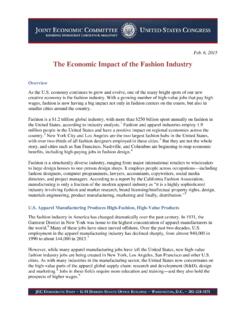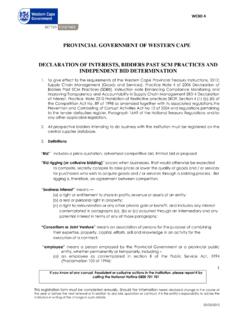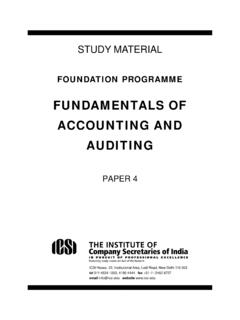Transcription of The next normal in construction - McKinsey & Company
1 The next normal in constructionHow disruption is reshaping the world s largest ecosystem June 2020 Cover image: Dong Wenjie/Getty ImagesCopyright 2020 McKinsey & Company . All rights reserved. This publication is not intended to be used as the basis for trading in the shares of any Company or for undertaking any other complex or significant financial transaction without consulting appropriate professional part of this publication may be copied or redistributed in any form without the prior written consent of McKinsey & 2020 The next normal in constructionHow disruption is reshaping the world s largest ecosystem This article was a collaborative, global effort among Maria Jo o Ribeirinho, Jan Mischke, Gernot Strube, Erik Sj din, Jose Luis Blanco, Rob Palter.
2 Jonas Bi rck, David Rockhill, and Timmy factors are reshaping the global economy, and no industry is immune to their impact. Grounded in the built, physical world, construction may seem less vulnerable to the impact of digital technologies and Silicon Valley disrupters. Indeed, the cranes accenting fast-rising urban centers and the workers on commercial and residential projects might lead some executives to believe that as it has been, so it shall be. In truth, construction is just as susceptible to these disruptions as other industries, but the ways in which the landscape will be affected are different.
3 In 2017, the McKinsey Global Institute (MGI) highlighted that the construction industry needs to evolve and showed ways in which it can change to improve productivity by 50 to 60 percent and deliver $ trillion a year in incremental global The call to action was heard: executives we speak to are thinking through how to prepare for changes ahead and they increasingly recognize that it s no longer a matter of if or when construction will be affected. Change is already COVID-19 crisis unfolding at the time of publishing this report will accelerate disruption and the shift to a next normal in the construction ecosystem.
4 Many executives are wrestling with the pandemic s economic turmoil, the shifts in demand it entails, and operating restrictions and longer-term safe working procedures. However, it is also critical for executives to lift their view to what the future will hold in terms of changes to business models and industry dynamics. It is in times of crisis that winners segregate from losers, and those who take bold moves fast can reap the research analyzes how the entire ecosystem of construction will change, how much value is at risk for incumbents, and how companies can move fast to adapt to and, in fact, create a new industry structure.
5 We relied on top-down reviews of industry dynamics, bottom-up analysis of Company data, and executive surveys to offer an unprecedented look at the entire value chain. In developing the report , we have sought to address the most pressing longer-term strategic Prefacequestions for executives in the ecosystem: how their part of the value chain will be affected, by how much, and what they should consider doing to prepare for a future that will differ radically from the present. Our hope is that these insights will help accelerate a transformation that we believe will and must happen and provide executives around the world with a map to help navigate the rough water ahead.
6 This research was led by Jan Mischke, partner at the McKinsey Global Institute (MGI) in McKinsey s Zurich office; Jonas Bi rck, associate partner based in Stockholm; Gernot Strube, senior partner in Munich and leader of the Capital Projects and Infrastructure Practice; Maria Jo o Ribeirinho, partner in Lisbon; Erik Sj din, partner in Stockholm; Jose Luis Blanco, partner in Philadelphia; Rob Palter, senior partner in Toronto; and David Rockhill, associate partner in London. We are grateful for the input, guidance, and support of Oskar Lingqvist, senior partner in Stockholm and Steffen Fuchs, senior partner in Dallas and coleader of our Capital Projects and Infrastructure Practice.
7 The project team was led by Timmy Andersson and comprised Nadja Bogdanova, Isak S derberg, and Richard Karlsson. Many McKinsey partners and colleagues offered helpful expert input, including Alex Abdelnour, Piotr Pikul, Nick Bertram, Subbu Narayanswamy, Marcel Brinkman, Matthew Hill, Gerard Kuperfarb, Priyanka Kamra, Niklas Berglind, Patrick Schulze, Nicklas Garemo, Koen Vermeltfoort, Fredrik Hansson, Ymed Rahmania, Frank Wiesner, Francesco Cuomo, Eric Bartels, and Kathleen Martens. Further, we wish to thank Gunnar Malm and Mats Williamson for their contributions to this report was edited by Scott Leff and David Peak and designed by Leff.
8 Daphne Luchtenberg, Suzanne Counsell, and Lukasz Kowalik helped disseminate the Jo o RibeirinhoJan MischkeGernot StrubeErik Sj dinJose Luis BlancoRob PalterJonas Bi rckDavid RockhillTimmy AnderssonJune 2020 ContentsIn brief Executive summaryRelated readingEndnotes12 Historically, the construction industry has underperformed 16A changing market environment, technological progress, and disruptive new entrants will trigger industry overhaul 2434 Almost half of incumbent value added is at stake41 Transformation will take time, but the COVID-19 crisis will accelerate change555 All players must prepare now for a fundamentally different next normal652483841 The construction industry, and its broader ecosystem, erects buildings, infrastructure, and industrial structures that are the foundation of our economies and are essential to our daily lives.
9 It has successfully delivered ever more challenging projects, from undersea tunnels to skyscrapers. However, the industry also has performed unsatisfactorily in many regards for an extended period of time. The COVID-19 pandemic may be yet another crisis that wreaks havoc on an industry that tends to be particularly vulnerable to economic market factors, combined with fragmented and complex industry dynamics and an overall aversion to risk, have made change both difficult and slow. The COVID-19 crisis looks set to dramatically accelerate the ecosystem s disruption that started well before the crisis.
10 In such times, it is more important than ever for actors to find a guiding star for what the next normal will look like in the aftermath and make the bold, strategic decisions to emerge as a studies have examined individual trends such as modular construction and sustainability. This report provides an assessment of how the full array of disruptive trends will combine to reshape the industry in earnest. Our research builds future scenarios based on more than 100 conversations with experts and executives, firsthand experience serving clients throughout the ecosystem, and reviews of other industries and their transformation journeys.


